Natural Dyeing for a painter's palette
June 2019
The six-week workshop was led by Marja Heuvelman, (Netherlands) with requirements given well in advance of the start date.
Using just eight natural dyestuffs, she successfully guided dyers towards the production of a basic painter’s palette.
The following photographs show how immersion dyeing lends itself to the creation of vibrant, bright colours.
Marja also provided guidance on extending this palette through the use of exhaust baths and additional dyestuffs,
as well as overdyeing techniques, with the possibility of achieving a range of eighteen colours.
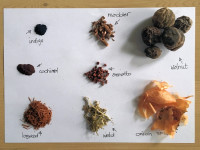
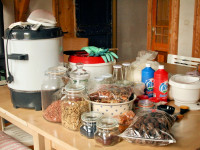
This display of tops (below) from Sonya Hammond, (Dorset, England) shows the range and intensity of colour that can be obtained from Marja's eight dyestuffs.

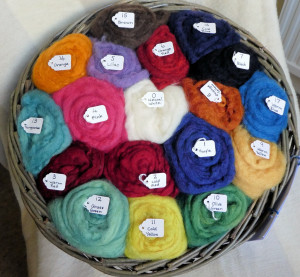
A basket of dyed tops (above) shows the range of colours possible through this workshop. Erika Hollingdale, (Edinburgh, Scotland) thoroughly enjoyed the workshop and selected her best results for the photo.
A different approach was taken by Sarah Cage, (Birmingham, England) who dyed skeins of yarn, as well as samples of blanket fabric. The photo gives an idea of the colour saturation achieved on both materials.
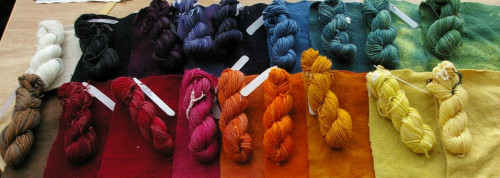
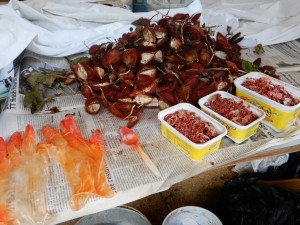
Elizabeth Chin, (Trinidad, in the Caribbean) had access to fresh annatto (Bixa orellana), although several hours of scraping seeds from the pods was necessary to obtain enough dyestuff.
Using exhaust baths provides additional colours from each dyestuff. This can be seen on these skeins of yarn from Katy Barrett, (Guernsey, Channel Islands) who used annatto. The results from the first bath are shown on the left, followed by subsequent immersions.
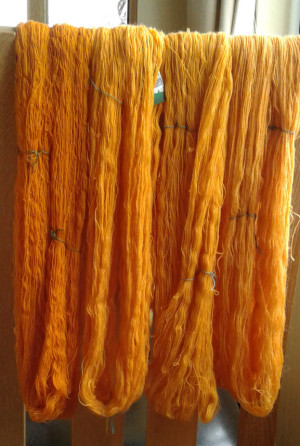
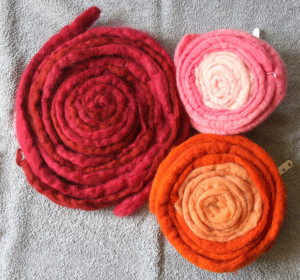
Another delighted dyer was Rita Corbett, (Dumfries, Scotland) who also appreciated the range and intensity of colours she obtained. Rita is considering designing and knitting either a jacket or a cardigan with her ‘painter’s palette’.
Each pair of skeins in Katy Barrett’s photo is the result of the original dyebath, together with a follow-up immersion in an exhaust bath.
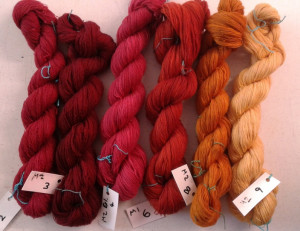
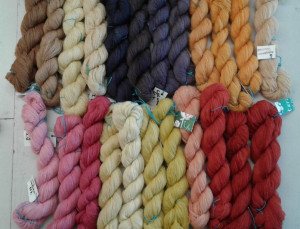
A further range of colours is possible from immersion in exhaust dyebaths, as shown in Katy Barrett’s photo showing these additional colours. Katy also dyed non-wool fibres, with interesting but paler results.
During Lockdown 2020 many of us spent time at home with our stashes. Frankie Owens, (Norfolk, England) used the yarns she had dyed on this workshop for a ‘Stay at Home Stashbusting’ activity. Her colourful woven throw demonstrates how well the painter’s palette can be put to good use. As they say, there are no colour clashes in nature.
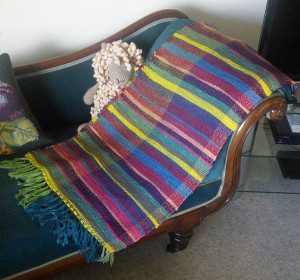
Marja Heuvelmaan is to be congratulated on leading such an inspirational workshop. She provided excellent notes and support throughout the six weeks, with rewarding results. In her introduction to the workshop Marja explained the possible uses of the palette: blending colours, as you would with paint, making batts or rolags, as well as felting or spinning. She also suggested dyeing singles yarn for blending in tapestry weaving.
Marja pointed out that natural dyeing takes time but this didn’t prove to be a deterrent: participants demonstrated their enthusiasm and were rewarded with a diverse and intense colour range. The detailed notes, together with advice, problem-solving and the sharing of experiences, ensured all gained in confidence.
